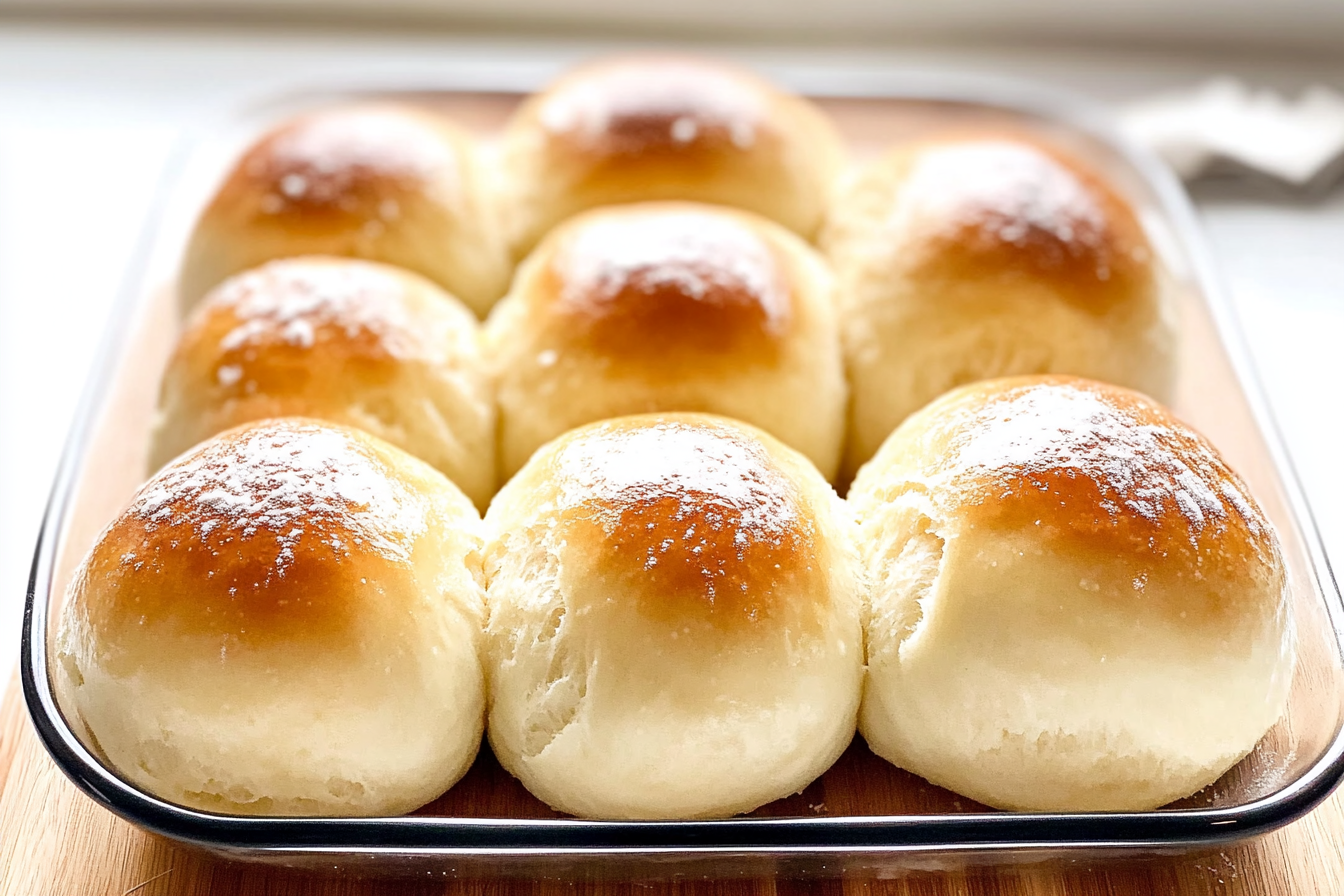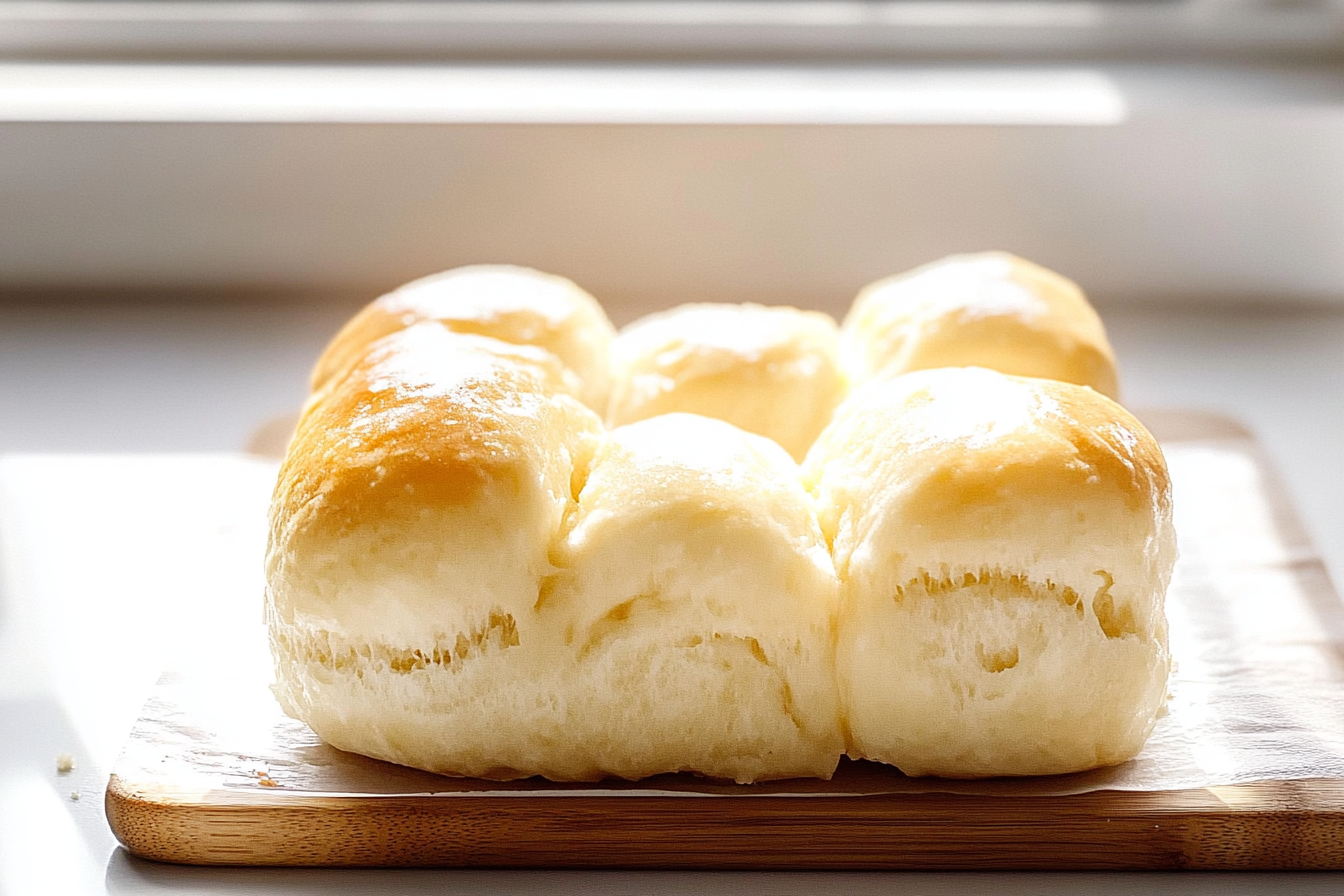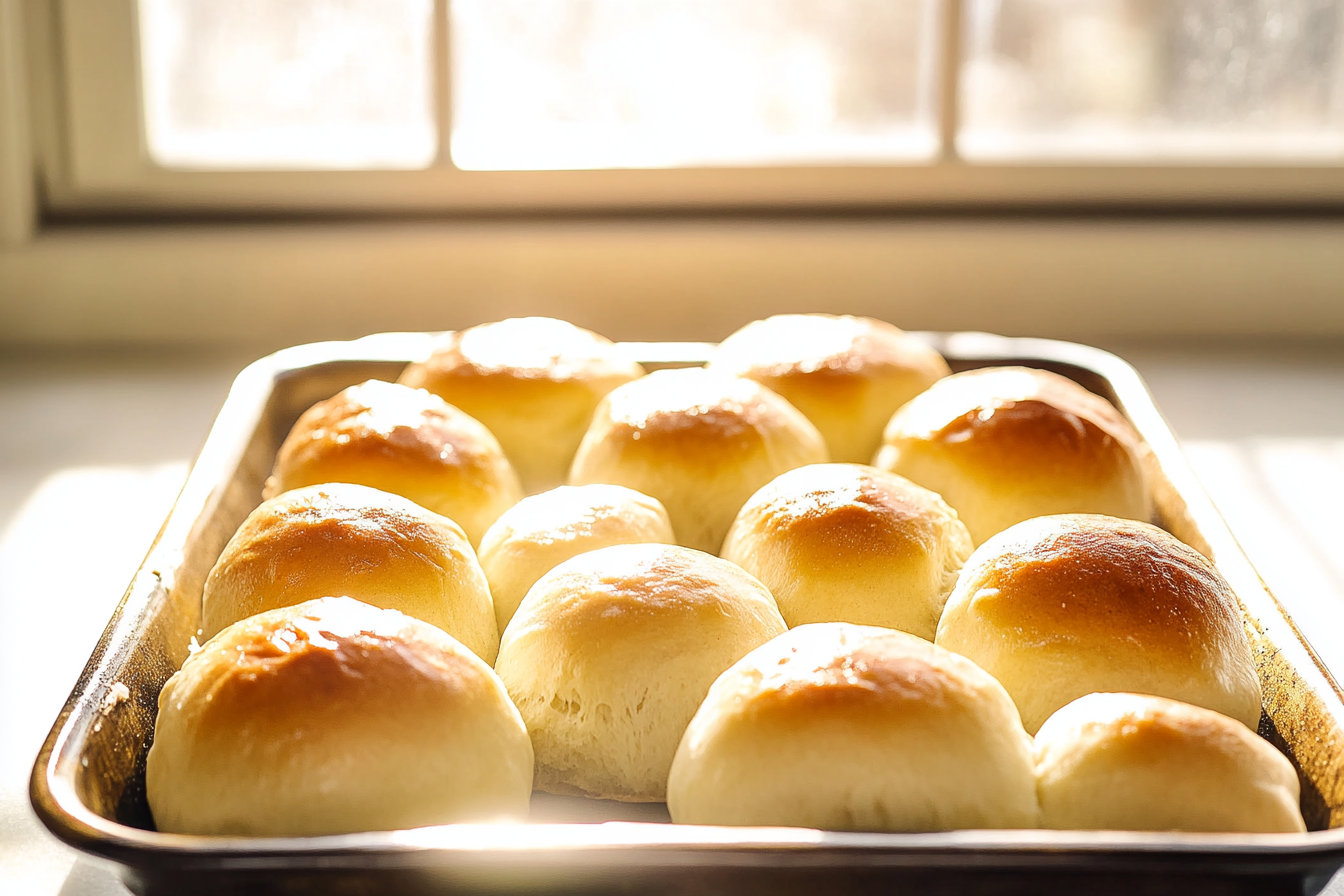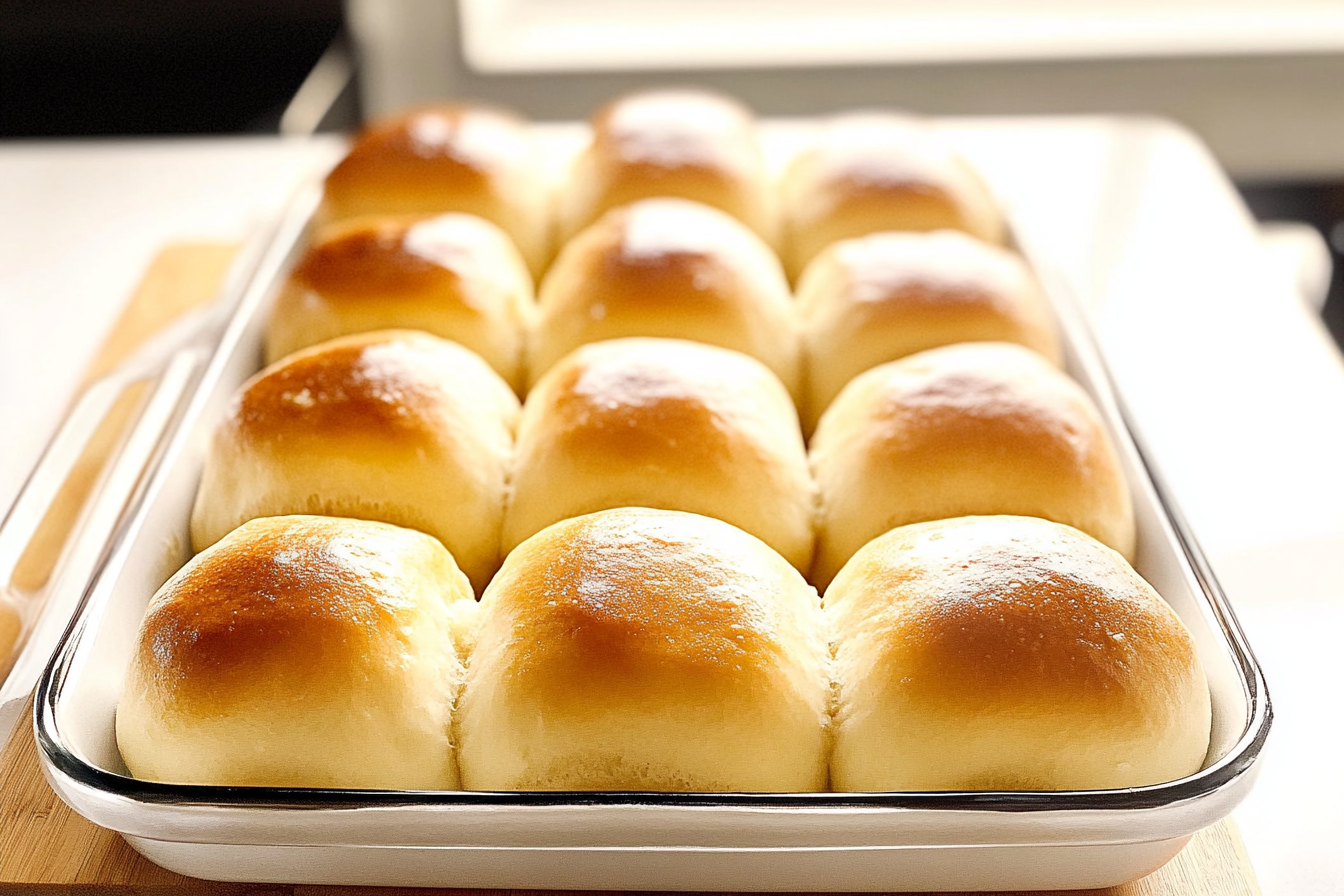Introduction to 1-Hour Soft and Buttery Dinner Rolls
In the heart of many family gatherings and festive feasts, the humble dinner roll has long held a cherished place at the table, cradled in a warm breadbasket at the center of laughter and love. Originating from the vast culinary traditions of Europe, bread rolls have evolved over centuries, influenced by regional variations in ingredients and techniques. The roots of the dinner roll can be traced back to the French petits pains and English yeast loaves, both of which share the common goal of enhancing any meal with their soft, inviting texture.
The 1-Hour Soft and Buttery Dinner Rolls bring this time-honored staple to the modern kitchen with a grace and ease that would make the bakers of yesteryear proud. In our bustling contemporary lives, where time is often a scarce commodity, these rolls promise the comfort of freshly baked bread without the long hours of rising and resting that typically accompany yeast breads. With a nod to the expressiveness of today’s culinary needs, this recipe condenses the essence of artisanal bread-making into just sixty minutes, without sacrificing the tender crumb and rich buttery flavor that make these rolls so irresistible.
For the home cook, this recipe presents an exceptional opportunity to bring the joy of homemade bread to the table with minimal fuss. The process becomes a therapeutic ritual, as kneading the supple dough offers a momentary escape from the digital humdrum and a chance to reconnect with the tactile pleasures of baking. As the kitchen fills with the nostalgic aroma of yeast and butter, anticipation builds for the moment the rolls emerge from the oven, golden and steaming, ready to complement any dish they accompany.
Bringing a plate of these 1-Hour Soft and Buttery Dinner Rolls to the table is more than just serving bread; it’s about recreating a tradition of warmth and hospitality, a testament to the belief that good food brings people together. Whether you are a seasoned baker or a novice in the kitchen, this recipe is crafted to ensure success, inviting you to partake in the age-old joy of sharing a freshly baked roll, the perfect companion to any meal.

“`html
Ingredients for 1-Hour Soft and Buttery Dinner Rolls
- 3 ½ cups (450g) all-purpose flour
- ¼ cup (50g) granulated sugar
- 1 packet (2 ¼ tsp or 7g) instant yeast
- 1 tsp salt
- ¾ cup (180ml) milk (substitute with almond milk or soy milk, if desired)
- ¼ cup (60ml) water
- ⅓ cup (75g) unsalted butter, cubed (substitute with margarine for a dairy-free option)
- 1 large egg
- Additional melted butter for brushing (optional)
“`
“`html
1-Hour Soft and Buttery Dinner Rolls Preparation Guide
- Preheat your oven to 180°C (350°F).
- In a large mixing bowl, combine 1 cup of warm milk (about 43°C or 110°F) with 2 tablespoons of granulated sugar and 2 1/4 teaspoons of instant yeast. Let the mixture sit for around 5 minutes until it becomes foamy.
- Add 1/4 cup of melted butter, 1 teaspoon of salt, and 3 cups of all-purpose flour to the yeast mixture. Gradually mix until a dough begins to form.
- Knead the dough by hand on a lightly floured surface or with a stand mixer equipped with the dough hook. Continue kneading for 5–7 minutes until the dough is smooth and elastic.
- Lightly grease a bowl with oil and place the kneaded dough inside. Cover it with a clean kitchen towel and let it rise in a warm place for 15 minutes.
- After the initial rise, punch down the dough to release any air bubbles. Divide the dough into 12 equal portions.
- Shape each portion into a ball and place them in a greased 9×13 inch baking dish, ensuring they are spaced evenly.
- Cover the baking dish with the kitchen towel again and allow the rolls to rise for another 15 minutes in a warm area.
- Once the rolls have risen, bake them in the preheated oven for 12-15 minutes, or until they are golden brown on top.
- Remove the rolls from the oven and brush them immediately with 2 tablespoons of melted butter to give them a shiny, buttery finish.
- Allow the rolls to cool slightly before serving. Enjoy your freshly baked, soft, and buttery dinner rolls!
“`
Advanced Tips for Perfect 1-Hour Soft and Buttery Dinner Rolls
- Enhance Flavor with Pre-ferment: To add depth to the flavor, consider preparing a pre-ferment or “biga.” Mix a portion of the flour, water, and yeast in advance and allow it to ferment for a few hours or overnight if time permits. Incorporating the biga into your dough will result in a more complex taste.
- Incorporate a Tangzhong: The Tangzhong method involves cooking a small portion of the flour and liquid to form a roux-like paste, which is then incorporated into the dough. This technique helps in retaining moisture, resulting in softer rolls with a longer shelf life.
- Use High-Quality Butter: Opt for European-style butter with a higher butterfat content to enhance the richness and flavor of your rolls. The slight tanginess and creaminess can greatly improve the final taste.
- Optimize Texture: For an airy texture, ensure your dough is slightly tacky and not too dry. If it’s too dry, sprinkle in a bit of extra water during kneading.
- Tools for Precision: Utilize a digital kitchen scale to measure ingredients accurately, ensuring consistent results. Dough scrapers can help efficiently handle and shape dough with minimal sticking.
- Prioritize Rolling Technique: When forming the rolls, ensure that you roll them tightly to avoid air pockets. This will help achieve uniform and professional-looking rolls.
- Baking Stone for Even Heat: For even heat distribution, consider using a baking stone. Preheat the stone in the oven before placing your rolls on it; this helps achieve a perfectly browned bottom.
- Steam Bake Method: To achieve a glossy, golden crust, introduce steam during the first few minutes of baking. This can be done by placing a small pan of water on the oven floor or spritzing water in the oven with a spray bottle.
- Avoid Overworking the Dough: Over-kneading can result in dense rolls. Knead just until the dough is smooth and elastic, which usually takes about 6-8 minutes with a stand mixer on medium speed.
- Proper Resting Time: Giving dough enough time to rest between shaping and baking allows for gluten relaxation, ensuring a tender crumb. While this recipe is quick, make sure not to skip the resting phases.
- Monitor Dough Temperature: Ideal dough temperature should be around 75°F (24°C) after mixing. Adjust your water temperature and room conditions to achieve this; too cold slows yeast activity, while too warm may overproof the dough.

“`html
Proper Storage of Leftover Dinner Rolls
To ensure your 1-hour soft and buttery dinner rolls stay fresh, store them in an airtight container or a resealable plastic bag once they have completely cooled down. This will help keep them moist and prevent them from drying out. If you plan to consume the rolls within a day or two, storing them at room temperature is sufficient. However, for longer storage, you can refrigerate or freeze them for extended freshness.
Refrigeration and Freezing
When refrigerating, place the rolls in a container that seals tightly to avoid absorption of any fridge odors. The rolls will remain fresh in the refrigerator for up to 1 week. If freezing, wrap each roll individually in plastic wrap and then place them in a freezer-safe bag or container. Stored this way, the rolls can be frozen for up to 3 months.
Reheating Instructions
For reheating, preheat your oven to 350°F (175°C). If the rolls are refrigerated, place them directly on the oven rack or on a baking sheet. For frozen rolls, it’s best to let them thaw at room temperature before reheating. Heat them for about 5-10 minutes until warm and soft. To maintain their buttery softness, you can brush them with a little melted butter before reheating.
Serving Suggestions
These dinner rolls are incredibly versatile and can be served alongside a variety of dishes. They pair perfectly with soups, stews, or any hearty main course. For a delicious breakfast or snack option, consider serving them with jam, honey, or a pat of butter. You can also get creative and use them to make sliders or mini sandwiches for a flavorful twist on classic favorites.
“`
“`html
Adapting “1-Hour Soft and Buttery Dinner Rolls” for Different Diets
- Vegan Adaptation:
– Replace butter with a vegan butter substitute or coconut oil for a similar texture and flavor.
– Use plant-based milk, such as almond or soy milk, instead of cow’s milk.
– Substitute eggs with applesauce (1/4 cup per egg) or a flax egg (1 tablespoon of flaxseed meal + 3 tablespoons of water, mixed and left to thicken for a few minutes).
– Expect a slight change in flavor, with a subtle hint of coconut or nuttiness depending on the milk and butter substitute used. - Gluten-Free Adaptation:
– Use a gluten-free all-purpose flour blend with xanthan gum to help the dough bind and rise.
– Gluten-free flours can lead to denser rolls compared to their wheat counterparts, so consider adding an extra rising agent or extending the rising time slightly.
– The texture might be less airy, but they should still be soft if adequately kneaded and allowed to rise. - Low-Carb Adaptation:
– Replace traditional flour with almond flour or coconut flour, but keep in mind that this will require adjusting the liquid content due to differences in absorbency.
– Using these flours can result in a different texture, often yielding a denser roll with a slightly nutty taste.
– Adding a leavening agent like baking powder can help maintain some fluffiness. Consider incorporating cheese or extra eggs to improve binding and flavor.
“`

Frequently Asked Questions About 1-Hour Soft and Buttery Dinner Rolls
What type of flour is best for these dinner rolls?
All-purpose flour works well for this recipe, providing a good balance of texture and flavor. For slightly fluffier rolls, you can substitute with bread flour.
Can I use instant yeast instead of active dry yeast?
Yes, you can use instant yeast. If you do, you don’t need to proof it first; just mix it directly with the dry ingredients. The rise time might also be slightly shorter.
How can I make these rolls dairy-free?
Substitute the butter with a plant-based butter or margarine, and use a non-dairy milk such as almond or soy milk.
Why didn’t my rolls rise properly?
Check the expiration date on your yeast. Also, ensure your liquid ingredients are warm (not hot) to activate the yeast, ideally between 100°F to 110°F (37°C to 43°C).
Can I prepare the dough in advance?
Yes, prepare the dough, let it rise, shape the rolls, and then refrigerate. Let them come to room temperature and rise slightly before baking.
How can I make the rolls more flavorful?
Brush the tops with garlic butter or sprinkle with herbs like rosemary or thyme before baking to enhance flavor.
What should I do if the dough is too sticky?
If the dough seems too sticky, gradually add small amounts of flour, about 1 tablespoon at a time, until the dough is manageable.
“`html
Conclusion
This 1-Hour Soft and Buttery Dinner Rolls recipe is a must-try for anyone looking to elevate their meal with delicious homemade bread that doesn’t require hours of preparation. The combination of fluffy texture and rich buttery flavor makes these rolls a delightful addition to any dinner table. The straightforward steps ensure that even beginner bakers can achieve bakery-quality results in record time.
We would love to hear how these dinner rolls turned out for you! Your feedback and variations can inspire others, so don’t hesitate to leave a comment and share your experience.
Enjoy your meal! Try this recipe and let us know your thoughts in the comments. 🍽️
“`

